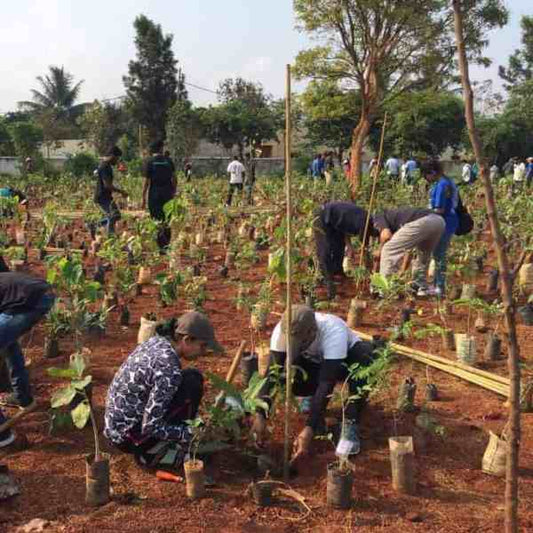ESG Tree Plantation
Tree plantation emerges as a powerful tool to address ESG goals effectively. By strategically integrating tree plantations into corporate sustainabili Read more
-
 Project Closed
Project ClosedTrees by LIFT Team for Green Diwali
Regular price ₹ 299Regular priceUnit price per -
Trees for a Greener Tomorrow - by Mahindra Lifespaces
Regular price ₹ 299Regular priceUnit price per -
Trees for Farmers
Regular price ₹ 299Regular priceUnit price per -
Trees for Environment
Regular price ₹ 299Regular priceUnit price per -
Trees for Environment Day (5th Jun)
Regular price ₹ 299Regular priceUnit price per -
Trees for Clients
Regular price ₹ 299Regular priceUnit price per -
 Project Closed
Project ClosedTrees for Bangalore
Regular price ₹ 799Regular priceUnit price per -
Trees for Employee Engagement
Regular price ₹ 49,950Regular priceUnit price per -
 Project Closed
Project ClosedTrees by Internet Brands | WebMD | FindLaw
Regular price ₹ 299Regular priceUnit price per -
Trees for Employees
Regular price ₹ 299Regular priceUnit price per -
 Project Closed
Project ClosedTrees for Delhi, NCR
Regular price ₹ 799Regular priceUnit price per -
Trees for a Greener Tomorrow - by Habitat India
Regular price ₹ 299Regular priceUnit price per -
 Project Closed
Project ClosedTrees for Mumbai
Regular price ₹ 799Regular priceUnit price per -
 Project Closed
Project ClosedTrees for Hyderabad
Regular price ₹ 799Regular priceUnit price per -
 Project Closed
Project ClosedTrees for Pune
Regular price ₹ 799Regular priceUnit price per -
Trees for Colleagues
Regular price ₹ 299Regular priceUnit price per
ESG Tree Plantation
Tree plantation emerges as a powerful tool to address ESG goals effectively. By strategically integrating tree plantations into corporate sustainability strategies, organizations can make significant contributions to environmental conservation, social welfare, and ethical governance practices.
Environmental Impact: Tree plantation plays a crucial role in mitigating climate change by sequestering carbon dioxide, reducing greenhouse gas emissions, and enhancing carbon sinks in forests and landscapes. Moreover, trees contribute to biodiversity conservation, soil stabilization, watershed protection, and air purification, thereby fostering resilient ecosystems and mitigating environmental risks.
Social Responsibility: Beyond environmental benefits, tree plantation initiatives promote social inclusion, community engagement, and economic empowerment, particularly in rural and marginalized areas. By involving local communities in tree planting activities, organizations can create employment opportunities, enhance livelihoods, and improve quality of life. Furthermore, trees provide essential ecosystem services such as food, fuel, medicine, and habitat, supporting human well-being and cultural heritage.
Governance Practices: From a governance perspective, tree plantation reflects a commitment to ethical business practices, transparency, and stakeholder engagement. By aligning tree plantation initiatives with ESG principles, organizations demonstrate responsible stewardship of natural resources, adherence to regulatory requirements, and accountability to shareholders, customers, and communities. Moreover, integrating tree plantation into corporate governance frameworks enhances risk management, reputation management, and long-term value creation.
Strategic Implementation: To leverage tree plantation for ESG goals effectively, organizations should adopt a strategic and holistic approach that aligns with their core values, business objectives, and stakeholder expectations. This involves setting clear sustainability targets, conducting thorough environmental assessments, engaging with local communities and indigenous peoples, fostering partnerships with governments, NGOs, and other stakeholders, and monitoring and reporting on the social, environmental, and economic impacts of tree plantation initiatives.

Tree plantation serves as a catalyst for advancing ESG goals, offering multifaceted benefits for the environment, society, and governance practices. By embracing tree plantation as a key component of their sustainability strategies, organizations can drive positive change, build resilience, and create shared value for all stakeholders. Together, let us harness the power of trees to build a more sustainable and equitable future for generations to come.
Achieving ESG Goals through Trees
Enhance your corporate ESG strategy with tree plantation initiatives. Planting trees not only contributes to environmental sustainability but also fosters social impact and good governance practices. Learn how integrating tree plantation into your ESG framework can align with sustainable business goals and enhance stakeholder engagement while addressing key environmental and social challenges.
Trees for ESG
Drive corporate sustainability goals with tree plantation initiatives. By investing in reforestation projects and green initiatives, businesses can mitigate climate change, promote biodiversity, and support local communities. Discover how tree plantation aligns with corporate sustainability objectives, enhances brand reputation, and creates lasting positive impacts on the environment and society.
Reforestation for Environmental Impact
Harness the power of reforestation to make a positive environmental impact. Planting trees restores degraded ecosystems, sequesters carbon dioxide, and enhances ecosystem services. Explore the benefits of reforestation for biodiversity conservation, climate change mitigation, and sustainable land management, and discover how your actions can contribute to a greener, healthier planet.
Social Responsibility and Tree Plantation
Embrace social responsibility through tree plantation initiatives. Engaging in community tree planting events, supporting agroforestry projects, and promoting environmental education empower local communities and enhance livelihoods. Learn how integrating social responsibility with tree plantation efforts can create shared value, foster resilience, and promote inclusive growth for all.
Governance and Tree Plantation Projects
Ensure effective governance in tree plantation projects for sustainable outcomes. Transparent decision-making, stakeholder engagement, and compliance with regulations are essential. Discover best practices for project management, monitoring, and evaluation to uphold ethical standards, mitigate risks, and maximize the social, environmental, and economic benefits of tree plantation initiatives.
Impact Investing in Tree Plantation
Explore impact investing opportunities in tree plantation for financial and social returns. Investing in sustainable forestry projects generates long-term value, promotes ecosystem resilience, and supports climate action. Discover how impact investors can align their financial objectives with environmental and social goals by supporting tree plantation initiatives that create positive, measurable impacts for people and the planet.
Browse Trees Plantations
FAQ
What does ESG stand for?
ESG stands for Environmental, Social, and Governance.
Why is ESG important for corporations?
ESG is important for corporations because it helps them assess and improve their sustainability practices, enhance reputation, mitigate risks, attract investors, and foster employee engagement.
What are some examples of environmental factors in ESG?
Examples of environmental factors in ESG include carbon emissions, energy efficiency, waste management, and natural resource conservation.
Can you provide examples of social factors in ESG?
Examples of social factors in ESG include labor practices, human rights, diversity and inclusion, community engagement, and product safety.
What does governance refer to in the context of ESG?
Governance in the context of ESG refers to leadership structure, board diversity, executive compensation, transparency, and ethical business practices.
How can corporations integrate ESG into their business operations?
Corporations can integrate ESG into their business operations by setting clear sustainability goals, implementing responsible policies and practices, engaging stakeholders, and reporting transparently on their ESG performance.
What are some benefits of embracing ESG for corporations?
Some benefits of embracing ESG for corporations include enhanced reputation, improved risk management, access to capital, increased innovation, and stronger relationships with stakeholders.
How does tree plantation contribute to ESG goals?
Tree plantation aligns with ESG goals by addressing environmental sustainability (E), social impact (S), and governance (G). It enhances biodiversity, mitigates climate change, improves air and water quality (E), provides employment, supports local communities, and enhances quality of life (S), and demonstrates responsible stewardship and accountability (G).
What specific ESG benefits can tree plantation initiatives offer?
Tree plantation initiatives provide various ESG benefits, including carbon sequestration and climate change mitigation (E), fostering community engagement and empowerment (S), and promoting sustainable land use and ecosystem resilience (G). They contribute to achieving multiple SDGs and demonstrate corporate commitment to environmental and social responsibility.
How can corporations integrate tree plantation into their ESG strategies?
Corporations can integrate tree plantation into their ESG strategies by setting targets for tree planting, engaging employees and stakeholders, investing in reforestation projects, and transparently reporting on environmental and social impacts. Incorporating tree plantation into ESG initiatives demonstrates a commitment to sustainable business practices and environmental stewardship.
What role does tree plantation play in addressing climate change, a key component of ESG?
Tree plantation plays a crucial role in addressing climate change by sequestering carbon dioxide, reducing greenhouse gas emissions, and enhancing carbon sinks in forests and landscapes. It contributes to climate action (SDG 13) and supports corporate efforts to mitigate climate-related risks and transition to a low-carbon economy.
How do tree plantation projects contribute to social impact, an essential aspect of ESG?
Tree plantation projects contribute to social impact by creating employment opportunities, supporting local communities, and improving livelihoods. They enhance community resilience to climate change, promote environmental education, and foster a sense of ownership and pride among stakeholders. Investing in tree plantation aligns with corporate social responsibility (CSR) goals and enhances brand reputation.






























